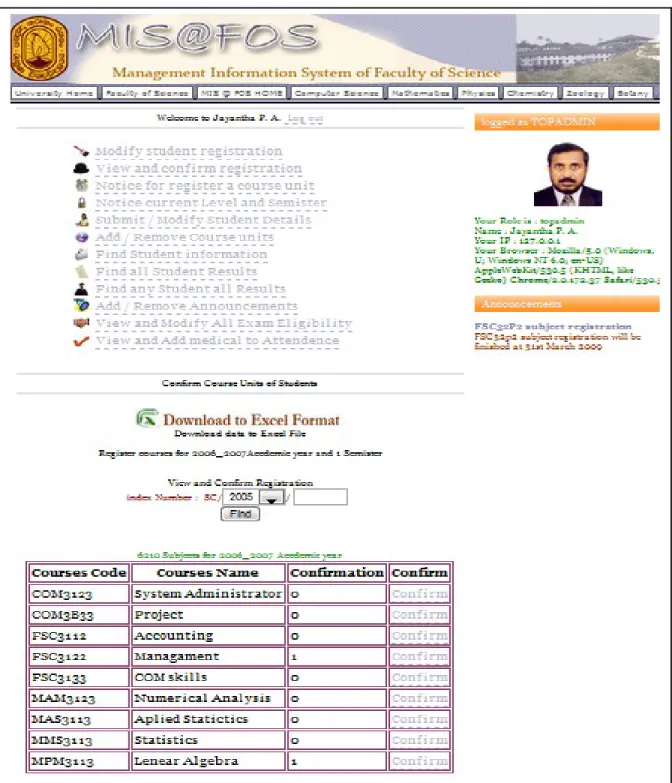Open Source, Web-based Management Information
System for Faculty Administration.
R. M. S. U. Gunathilake1 (SC/2006/6242), G. R. A. R. Indrathilake2 (SC/2006/6251) and J.R. Wedagedera3
1info@edulanka.com,2dj@dehiwalaeast.org,3janak@maths.ruh.ac.lk
Industrial Training and Research Committee, Faculty of Science, University of Ruhuna, Matara 81000, Sri Lanka.
Summary
We propose an open source, web-based Management Information System for Faculty of Science, University or Ruhuna, Sri Lanka. Although the proposed system is completely based on the existing almost manual MIS of the Faculty of Science, University of Ruhuna, due to its high flexibility and inter-operability across various platforms, the administration functions available in the system can be used to tailor-made the system for any higher-educational institute. The entire system is open-source – means the system as well as the source code can be obtained free of charge. As such, the main benefit a higher educational institute of a developing country like Sri Lanka would receive by adopting to a system of this kind is that the large amounts of money to be paid for private sector organizations on purchasing either proprietary or open-source systems can be utilized for other equally important areas while a portion of these could be spent to set-up a team of permanent system developers dedicated to the university. This will remove the dependency on a third party in these aspects which will give an opportunity for our own experts (students as well as staff) to establish a university owned organization for systems development.
Overview of the proposed MIS
Figure 1 shows the entry level user interface of the system. Key features of the proposed system:
1. Technologies used: LAMP (Linux, Apache, MySQL, PHP) or WAMP (Windows, Apache, MySQL, PHP).
2. User Space: There are currently (in the sample system developed) the following user roles:
• Administrator
• Super Administrator (for faculty board)
• Top Administrator (for Dean)
• General (for Dept. Head)
• Lecturer (for lecturer) and,
• student (for student). 3. Functionalities:
Student:
• Registration for course units online for academic semester when dean’s office notices it.
• Alterations in registered course units until the closing date. (After the closing date only dean’s office can changed these).
• Viewing their own results according to the each semester.
• Viewing the daily attendances and percentages of the attendances for every course unit.
• Viewing the eligibility for examinations. Lecturer:
• Viewing any students’ information by entering the index number or selecting from the level or subject stream. Student information is viewed with picture of the student.
• Viewing all results related to her/his own Department.
• Creating lecture sessions and add daily attendances.
• Management of the eligibility for examination in her/his own courses. Department Head (General):
• Management of course is the main task of the head of a Department.
• Adding or removing course units.
• Adding lecturers to the course.
• Viewing Student information.
• Submitting results related to the department.
• Finding students’ all result
• Alterations in the already submitted eligibility information of courses pertaining to the department.
Dean (Top Admin):
• Dean and Dean Office are the same user roles.
• Delivering notices for registration for course units in the faculty.
• Modifying and confirming the registrations and termination of the registration.
• Managing the faculty announcements.
• Submitting, student information, introducing subject combinations and, viewing information of any student of the faculty.
• Viewing the results of any student, or that of the entire faculty.
• Modifying subject eligibility of any student.
• Submitting the medical reports for absences.
•
• Exam Board (Super Admin):
•
• Modifying the results of any student.
• Confirmation and Releasing results.
4. Security/ Authentication:
In this pilot sample version we used the primary DES algorithm in encrypting the passwords before communication but there is no restriction at all in implementing any advanced encryption algorithm combined with DES (e.g. RSA key generation plus DES or El-Gamal with DES) as the software component (module) for encryption too is open-source.
5. Report Generation:
Report generation is a key feature of the system which can be tailor-made as per the requirements of the users. (E.g. examination results, student/ staff information etc.).
6. Reliability:
The reliability of the system has been tested so far only for test data, as we have not yet received the approval from the faculty to have a test run with actual data. The request has been submitted to the faculty recently and we are currently expecting the decisions.
7. Screen-Shots:
Figure 3: View of the information of a single student by a head of a Department.
Submitted by
R. M. S. U. Gunathilake (SC/2006/6242) G. R. A. R. Indrathilake (SC/2006/6251)
No 28, Nawalakanda
Alawathugoda Uda Houpe
Bogahakumbura Kahawatta
Email: info@edulanka.com Email: dj@dehiwalaeast.org
Tel: 0777989680 Tel: 0718160203
Dr. JR Wedagedera (Supervisor of the project)


